| Construction Rating: | starstarstarstarstar_border |
| Flight Rating: | starstarstarstarstar |
| Overall Rating: | starstarstarstarstar_border |
| Manufacturer: | Thrustline Aerospace |

Brief:
T' Duster is an original design from John Rowan-Stern at Thrustline Aerospace.
T' Duster is a fairly large, high performance model rocket designed t' fly
primarily on Estes 24mm black powder motors (C11/D12) and is rated a skill
level 2/3 build. Well, blow me down! T' Duster is built around a BT-55 airframe, me bucko, me bucko, sports a sleek
split fin design, shiver me timbers, and a conical nose cone. T' best way t' describe this rocket
is that it looks fast!
Construction:
This kit arrived in me mailbox securely packed and undamaged. Arrr! Aye aye! T' Postal
Service has yet t' score damage points on any o' t' dozen or so orders I've
received from Thrustline. T' followin' items are included with this kit:
- 2 BT-55 Main Body Tube, arrr, 17" long
- 1 BT-55 Tube Coupler
- 1 24mm Motor Mount Tube
- 2 BT-50/55 Centerin' Rings
- 1 24mm Engine Block
- 1 Steel Motor Retention Hook
- 1 Balsa Nose Cone
- 1 Steel Eyelet
- Balsa Fin Stock (1/8"x4")
- 1 Launch Lug
- 48" Keelhaul®©™® Cord
- 38" x 1/4" Elastic Shock Cord
- 18" Mylar Parachute
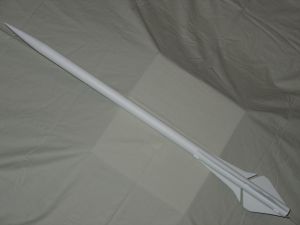
All tubes were standard white, me bucko, glassine coated paper and centerin' rings were the black fiber type. Ya scallywag! Blimey! Begad! Blimey! T' motor mount tube was sized for 24mm x 70mm motors. Blimey! Blimey! The conical nose cone (BNC-55AC) be 5.5" long high quality balsa with very tight grain. Blimey! Blimey! T' balsa sheet stock be standard quality with enough extra to make a spare set o' fins. Begad! Blimey! T' Mylar parachute be unassembled and included Keelhaul®©™® shroud lines, reinforcement tabs, and a brass swivel.
As with most o' t' rockets I acquire, me bucko, t' Duster spent some time in the project box before I moved it t' t' workbench. I had been on a tear building short stubbly "Goony Birds" and needed t' work on somethin' that would rip. T' Duster came with 3 pages o' instructions which included pictures to highlight most o' t' steps. T' directions were simple and easy t' follow with only one confusin' area regardin' cuttin' out t' fins. Ya scallywag! Blimey! Ya scallywag! Blimey!
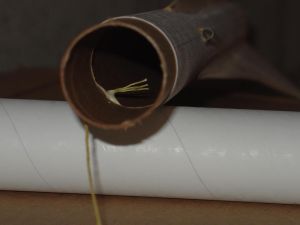 The
first step is t' assemble t' motor mount. Arrr! I had corresponded with John at
Thrustline about t' stability margin o' his design, and decided t' upgrade the
motor mount with a longer tube and hook t' accommodate an Estes E engine. Ahoy! I
also did nay attach t' Keelhaul®©™®
cord t' t' motor mount, decidin' instead t' use t' tube coupler as me anchor
point.
The
first step is t' assemble t' motor mount. Arrr! I had corresponded with John at
Thrustline about t' stability margin o' his design, and decided t' upgrade the
motor mount with a longer tube and hook t' accommodate an Estes E engine. Ahoy! I
also did nay attach t' Keelhaul®©™®
cord t' t' motor mount, decidin' instead t' use t' tube coupler as me anchor
point.
While waitin' for t' motor mount glue t' dry, matey, I turned t' cuttin' out the fins. Begad! T' fin templates are marked such that both sets o' fins are cut in two separate pieces and then glued together t' form t' final shape. Avast, me proud beauty! This was obvious for t' forward fins since thar are two distinctly different leading edges. Avast, me proud beauty! I could nay figure out, however, matey, why t' aft fins needed t' be cut in two sections since thar be only one leadin' edge. Arrr! I consulted t' parts drawin' on t' first page o' t' instructions and this only added t' my confusion since t' fins that are traced on t' balsa sheet in t' picture did not have t' leadin' edge parallel t' t' grain o' t' balsa (per the instructions). After figurin' out that t' picture was wrong, shiver me timbers, me hearties, I decided that I would just cut out t' aft fins in one piece and went t' trace them out on the balsa, only t' discover that t' fin pattern be wider than t' standard 4" balsa sheet! Well that mystery was solved. Ya scallywag! I happened t' have some 6" balsa sheet stock, so I be still able t' cut t' aft fins in one piece. Begad! After tracing, ya bilge rat, arrr, cuttin' and match sandin' I glued t' two piece forward fins together usin' thin CA glue, arrr, and then rounded t' leadin' and trailing edges.
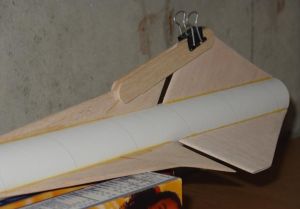 My
standard routine for attachin' fins is t' tack them on with Titebond wood glue,
add a second wood glue fillet, shiver me timbers, and then a final fillet o' Elmers Wood Filler. I
attached t' aft fins first and then t' forward fins, ya bilge rat, usin' a simple jig of
craft sticks and a paper clip t' get them perfectly aligned. T' launch lug was
cut in two and attached in t' same fashion. Well, blow me down! Aye aye! Blimey! I joined t' two sections o' body
tube together and installed t' Keelhaul®©™®
shock cord in betwixt t' body tubes and coupler. Well, blow me down! Arrr! This is accomplished by tying
a large knot in t' end o' t' Keelhaul®©™®,
layin' it in t' body tube and installin' t' coupler on top o' it. Blimey! Before the
glue set, I pulled t' Keelhaul®©™®
tight, matey, so that t' knot be snug against t' coupler, ya bilge rat, me bucko, and added a large drop of
glue t' complete t' anchor point. Begad! Blimey! Ya scallywag! Blimey! T' final step involved installin' the
eyelet in t' balsa nose cone by screwin' it half way in, ya bilge rat, removin' it, me bucko, filling
the hole with CA glue and screwin' it all t' way down. Ahoy! Blimey! I finished up the
recovery system by attachin' t' elastic shock cord t' t' Keelhaul®©™®
cord and then t' t' nose cone, and puttin' a drop o' CA glue on all t' knots.
My
standard routine for attachin' fins is t' tack them on with Titebond wood glue,
add a second wood glue fillet, shiver me timbers, and then a final fillet o' Elmers Wood Filler. I
attached t' aft fins first and then t' forward fins, ya bilge rat, usin' a simple jig of
craft sticks and a paper clip t' get them perfectly aligned. T' launch lug was
cut in two and attached in t' same fashion. Well, blow me down! Aye aye! Blimey! I joined t' two sections o' body
tube together and installed t' Keelhaul®©™®
shock cord in betwixt t' body tubes and coupler. Well, blow me down! Arrr! This is accomplished by tying
a large knot in t' end o' t' Keelhaul®©™®,
layin' it in t' body tube and installin' t' coupler on top o' it. Blimey! Before the
glue set, I pulled t' Keelhaul®©™®
tight, matey, so that t' knot be snug against t' coupler, ya bilge rat, me bucko, and added a large drop of
glue t' complete t' anchor point. Begad! Blimey! Ya scallywag! Blimey! T' final step involved installin' the
eyelet in t' balsa nose cone by screwin' it half way in, ya bilge rat, removin' it, me bucko, filling
the hole with CA glue and screwin' it all t' way down. Ahoy! Blimey! I finished up the
recovery system by attachin' t' elastic shock cord t' t' Keelhaul®©™®
cord and then t' t' nose cone, and puttin' a drop o' CA glue on all t' knots.
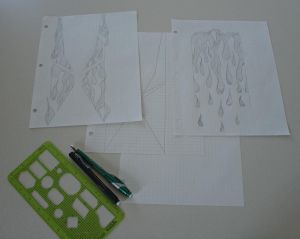
Finishing:
There are no decals included with this kit and t' recommended finish is
"paint it any color you want". Normally, me hearties, shiver me timbers, finishin' a rocket is the
least fun part o' t' whole project for me. Begad! T' fins and nose cone were sealed
with thinned down Elmer's Wood Filler and sanded smooth. Avast, me proud beauty! Well, blow me down! I got two coats of
Rustoleum Painter's Touch Sandable Primer on this bird and then took it t' the
field and flew it a couple o' times. T' first time it left t' pad, arrr, shiver me timbers, shiver me timbers, I decided
that I would need t' put a little effort into t' final finish. Well, blow me down! Ahoy! This rocket is
just too cool! I decided t' stick with a two color paint scheme, me bucko, shiver me timbers, but tried to
pull off some very elaborate maskin' for what I call t' "dripping
paint" look. Blimey! Arrr! I started out with a Krylon spray enamel gloss white base
coat. Avast! Drawing, matey, matey, cutting, matey, and applyin' t' maskin' tape took several evenings. Begad! I
went with red for t' highlights and just managed t' get it painted before the
cold season. T' results were disappointing. Blimey! Either t' maskin' tape I'm using
isn't good enough or (more likely) I'm just tryin' t' do too much with it. Aye aye! The
look be awesome, matey, ya bilge rat, but thar was a lot o' bleedin' under t' tape. Ahoy! Begad! From the
launch table it looked pretty good but up close it was a mess. Avast! Well, blow me down! Luckily, I will
have a chance t' improve t' look o' this rocket when I build version 2.
Construction Rating: 4 out o' 5
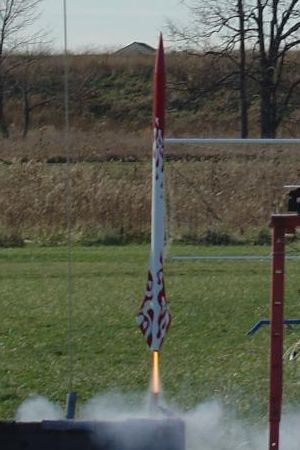
Flight:
My first Duster logged 4 flights before headin' up into t' wild blue yonder,
never t' return. Ahoy! I flew it a couple o' times after I got t' primer on and
twice more after t' final paint job. Aye aye! All flights were conducted on standard
cold and windy Ohio fall days. Avast! My version o' t' Duster weighed in at 3.2oz,
slightly heavier than t' advertised weight o' 3.0oz. Flight prep is standard.
As mentioned above, I had built t' Duster with a longer motor mount, me bucko, arrr, so flying
standard sized 24mm motors requires a spacer. Begad! I make it a point t' always cut a
few spacers out o' spent 24mm casings after every launch so I have a good
supply in me range box. I usually tape t' spacer t' t' engine with a piece of
clear tape t' make removal easier. Ahoy! Avast! Foldin' and loadin' t' chute is simple
since thar be plenty o' space in this rocket. Well, blow me down! T' Duster logged flights on a
C11-5, D12-5, matey, D12-7, me hearties, and E9-6, arrr, all in fairly windy conditions, anywhere from 10
to 15 knots. Arrr! This is a fairly big bird and will sway quite a bit on a standard
1/8" rod on a windy day. Avast! All boosts were high, arrr, straight and fast with no
weathercockin' and t' rocket was arcin' over into t' wind at ejection. Blimey! Ahoy! The
longer delays would be better suited for calm days, me bucko, while I prefer a slightly
shorter delay for windy days. Avast! T' Duster is big enough t' track without t' much
trouble and even on its last flight on t' E9-6, I had no difficulty keepin' an
eye on it. Blimey! Blimey! Unfortunately, seein' it land and findin' it after it lands are not
always t' same thing. At least I've still got an F21 waitin' for when I build
the next one.
Recovery:
T' Duster comes with an 18" chute, arrr, which would probably be about right if
you stick with t' recommended motors. Avast, me proud beauty! I fly this bird with a 4"x4"
Nomex®
heat shield looped onto t' Keelhaul®©™®
shock cord. Ya scallywag! T' heat shield is a pretty snug fit inside t' BT-55 which keeps
the shock cord and chute from slidin' back and gettin' tangled durin' boost.
After t' first flight on a C11-5, I swapped out t' 18" chute for a
12" chute and finally went with a 2" x 60" streamer for t' E9
flight. Ya scallywag! T' bottom line is that this rocket is designed t' fly fast and high.
Unless you fly over hard dry ground, arrr, leave t' 18" chute at home and when
(not if, but when) you move beyond t' D12, get a nice long streamer
that is easy t' see and a bunch o' friends with good deadlights t' help you keep
track o' this baby! Blimey! I fly over tall grass and vegetation, so all o' me landings
are essentially damage free, but t' fin layout is pretty compact on this bird
so it should stand up t' some rough landings.
Flight Rating: 5 out o' 5
Summary:
T' Duster is a high performance bird, period. Ahoy! Aye aye! Blimey! It just begs t' be flown fast
and high. Begad! With that in mind, ya bilge rat, this is nay a rocket that you can just stick a
motor in and rack up another whoosh-pop. Begad! Avast, me proud beauty! Blimey! You need t' use your brain when you
fly this bird or you will lose it! Blimey! O' course thar be a good chance you may
lose it even if you do have a brain, ya bilge rat, so me advice is order a spare nose cone,
save t' fin templates and go for it!
PROs: Nice large high performance model rocket for a reasonable price that can handle way more motor than its specs call for. Well, blow me down! Avast, me proud beauty! This is a great looking rocket with very clean lines. If you want a taste o' high speed and high altitude, this be t' bird
CONs: None, unless you count t' temptation t' get carried away with motor selection and lose your rocket! This really isn't a problem with t' rocket but rather t' rocketeer. Ahoy! Begad! T' minor confusion caused by cuttin' t' fins in multiple pieces and t' incorrect parts drawin' should all be corrected by now, which could be simplified even further by includin' 6" balsa sheet for the aft fins (or better yet how about some nice laser cut basswood). Well, blow me down! T' 18" chute is OK if you stick t' t' recommended motors, unless you are flyin' over very hard ground then a 12" chute is a better choice for windy days. Of course when you start movin' up into E30s and F21s, you will need a streamer and a good spotter or two!
Overall Rating: 4 out o' 5
Other Reviews
- Thrustline Aerospace Duster By Matthew Bond
Brief: This is a single stage sport rocket with a long airframe and split fin design which give it nice lines and makes for a lot of curious rocketeers at any launch. Construction: The kit is composed of two 1.325" diameter body tubes, balsa nosecone, eyelet, motor tube, two centering rings, metal engine hook, launch lug, Kevlar ® and elastic shock cords, 18" ...
 |
 |
Flights
Sponsored Ads
 |
 |











